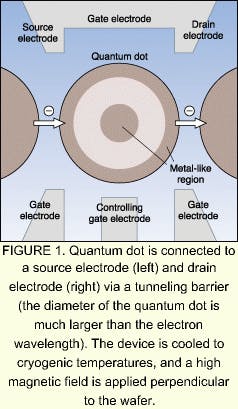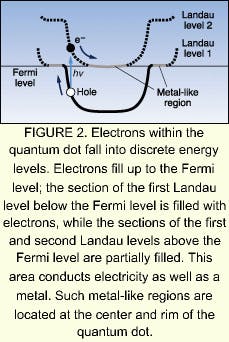Incorporating news from O plus E magazine, Tokyo
TOKYOSusumu Komiyama and colleagues at the University of Tokyo Department of Basic Science, a group affiliated with Japan Science and Technology Corp. (Tokyo), have developed a high-sensitivity optical detector that can detect single photons in the far-infrared (IR) region. The device contains a quantum-dot single-electron transistor.
FIGURE 1. Quantum dot is connected to a source electrode (left) and drain electrode (right) via a tunneling barrier (the diameter of the quantum dot is much larger than the electron wavelength). The device is cooled to cryogenic temperatures, and a high magnetic field is applied perpendicular to the wafer.
The far-IR region is important in the field of spectroscopy because information about the spin state of molecules, as well as the vibrational state of atoms within a material, can be collected. However, existing optical detectors have not been sensitive enough for this purpose. The new detector is able to detect incident photons at a rate of 0.1 photon/s over an effective surface area 0.1 mm2an improvement of four orders of magnitude compared to existing devices.
The detector contains a 500-nm-diameter quantum dot that is created using a gate electrode on a gallium arsenide/aluminum gallium arsenide heterostructure single-crystal wafer (see Fig. 1). Current applied to the device changes when far-IR light is incident on the dot, providing the means for sensing.
The electrons within the device are in a magnetic field, so they orbit in the plane perpendicular to the field. In the world of classical mechanics, this is cyclotron motion where the radius and energy of the particle can be specified. However, in the world of quantum mechanics, the energies are discrete and split into Landau levels (see Fig. 2).
When a photon with an energy equal to the energy difference between the two Landau levels strikes the quantum dot, an electron in the first Landau level is excited to the second level, and an electron/hole pair is created. The wavelength of photons that can be absorbed ranges from 175 to 210 µm, depending on the strength of the magnetic field. The excited electron quickly falls to the bottom of the second Landau level, and the hole rises up along the edge of the first Landau level. The resulting single electron/hole pair causes a change in the electrochemical potential of the rim of the quantum dot. When this matches the electrochemical potential between the source and drain electrodes, electricity is conducted; the quantum dot functions as a single electron transistor.
Adjusting the voltage across the electrodes causes the electrochemical potential to match when there is no electron/hole pair and not to match when a pair is formed and vice versa. The lifetime of the electron/hole pair is very long, so current can be switched during the excited state; this is the cause of the high sensitivity and the device's ability to detect single photons.
Courtesy O plus E magazine, Tokyo

